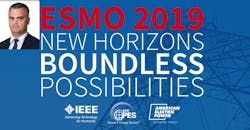ESMO 2019: Q&A With Dr. Bálint Németh
At ESMO 2019, experts from around the world will present information on a variety of different topics. For example, Dr. Bálint Németh, associate professor at the Department of Engineering and manager of the High Voltage Laboratory at the Budapest University of Technology and Economics, will lead a panel discussion titled, "Live Working in the EU."
This Q&A dives into the topic of how live-line working differs from one country to the next in the EU and what to expect to hear during Németh's session.
Q: How do you feel about speaking at ESMO 2019?
A: It is always an honor to talk about my field of expertise to colleagues from all around the world. ESMO is a great opportunity to exchange practical experiences and compare tools, technologies and equipment applied during live activities worldwide.
Q: What was the inspiration for the topic of your session, "Live Working in the EU?"
A: Hungary was one of the pioneers in the 1960s in the field of live working (especially barehand) and this is a nice heritage we are proud of. In EU priorities, technologies and aspects of live working vary from country-by-country, so it is very exciting to somehow synchronize these activities. Although geographically countries are close to each other, it is often really hard to cooperate in the field of live working due to the different laws, regulations and rules.
Q: You have a variety of speakers on this panel from different countries. Talk about the different perspectives they will bring to the discussion.
A: Legal background and philosophy of governmental control varies widely in the EU. Although technologies and equipment are pretty similar, the ratio of live activities and motivation may differ extensively in each case.
Q: How has the equipment and technology in Europe for live line working changed over the years?
A: Basically, some of the roots of live working are connected to Europe. Of course, as technology evolves, equipment became more reliable and safer than before. New arrangements and geometries in the grid also induced the need of revision of existing live working techniques.
Q: Talk about the differences in live line working from one country to the next. For example, according to the abstract, France is a leader in live line technology, and Italy has its own barehand practices and equipment.
A: In practice, in the EU, there are several countries, which lead live working equipment and technology development. Traditionally, some are focused on low and medium voltage, while others are experts in the field of high voltage.
Q: Why do you think the level of live line work is increasing in Europe, especially on the distribution side?
A: A lot of small countries report year-by-year that the number of live activities is continuously increasing. It is even common that live working has begun in the last decades in several countries.
Q: You work as an associate professor and as the manager of the High Voltage Laboratory at Budapest University Technology & Economics. What are some of the recent innovations in research and development for live line work?
A: Several EU-funded projects of the Laboratory are related to live working. In the last few years, technology development for high-voltage live-line maintenance was performed in cooperation with the Hungarian TSO. Some of the new results are composite insulator replacement in case of compact geometries, development of a new type of conductor car and mounting chair and extension of existing technologies for the whole grid.
Q: Hungary was one of the pioneers of high-voltage, barehand work in the 1960s. How have the practices and technologies changed since that time?
A: There was a break in high voltage LLM at the end of 1990s. Since that time, Hungarian TSO uses an imported technology from Italy due to the lack of resources in manufacturing as the country's industry has changed over the years.
Q: Talk about your education and background. How did you get interested in working in this industry?
A: High Voltage Laboratory is a unique facility to validate theoretical theses in practice. Working with such voltage and current levels allow us to be actively involved in any research, development or innovation projects, not only in Hungary, but nowadays all over EU.
Q: What do you think attendees can learn by attending your session, and what are some benefits of registering for the ESMO 2019 conference?
A: ESMO is an outstanding conference in the field of live working. Exchanging experiences and talking to experts of this field allows the participants to get familiar with new techniques, learn from each other, and last, but not least, have a great time in Columbus, Ohio.
To attend this session, register for ESMO 2019, where you can earn professional development credits, meet new friends and connect with new peers and learn about the latest technology and research practices in the industry. The event is hosted by American Electric Power and sponsored by IEEE-PES.
